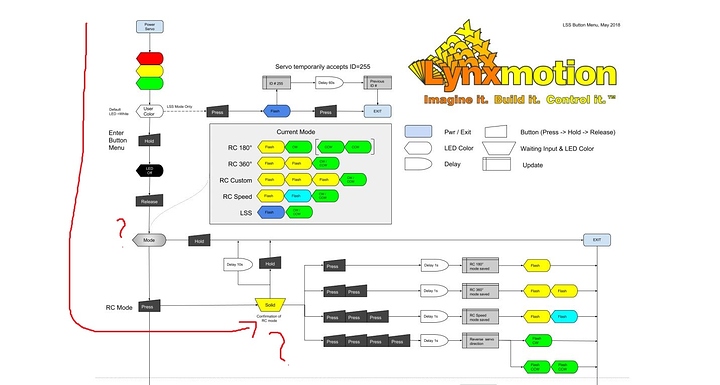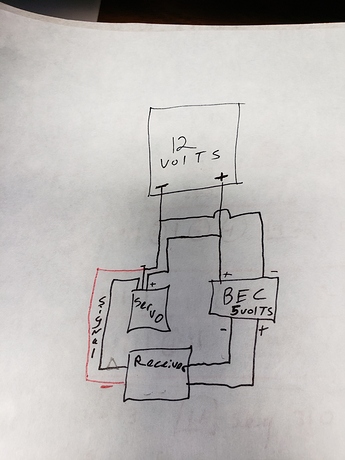I am trying to connect a few HT1 servos to a standard RC and not fully understanding your instruction. Can you please offer some help?
I push the buttons as directed to get into RC mode but then it just starts blinking red on and off and the RC does nothing.
Could you tell me which exactly RC system are you using?
Instruction says: Any RC system can be used, though 6-12 V power to the LSS servo(s) should be provided separately.
I am pushing the required buttons to get the servos into RC mode but after the led flashes and says it is in the correct mode the led begins to flash red. I have the servos supplied with 12 volts and the receiver supplied with 5 volts. I get no movement out of the servos.
Ok, let’s see from the chart at which step you are.
Current mode: What is it? How does it flash?
After confirmation of RC mode, what are your next steps?
@starwarsbricker
You are on the right track as the blinking mean you are in RC and the servo do not see any valid signal.
Can you post a picture of your setup (wiring) and explain the equipment used ?
Then I press the button twice to get into 360 mode and it blinks yellow twice. Then it blinks red, yellow, green and then it starts blinking red.
So it is supposed to be blinking Red?
@starwarsbricker, probably no RC pusle is received, so the servo goes limp. Also pulses which cannot be interpreted by the servo (ex. constant LOW or HIGH) may cause the servo to go limp.
Take a picture of your connection.
This is the confirmation that it is now in RC 360° mode.
This is the boot-up procedure (bootloader), indicating the LSS did a soft reset.
As @dialfonzo and @igor_X mentioned, this indicates the LSS is not receiving a valid RC control signal.
Yes, the LSS will go limp if it does not receive a valid RC signal (including all LOW and all HIGH).
It should be noted that holding HIGH for a while will turn the LSS back into smart mode. You can read more about this on the Lynxmotion Wiki here. Here are the details below for quick reference:
Ok I am getting signal to the servos now but the servos are jumpy and not smooth. Any idea there? I am powering them with 12 volts and powering the receiver with 5 volts
@starwarsbricker You indicate you’re powering the receiver with 5V - normally that also provides power to the servos. Can it be that that you have two sources of power competing against each other? If not, can you provide a diagram or photos? Have you updated to the latest firmware version 362? Given that you have multiple servos, disconnect the rest and let’s troubleshoot only one at a time.
Here is how I have one of the servos wired. I do not have competing voltages. The firmware has been updated to version 362. I have tried 2 different systems and I am getting the same issue. Both of the receivers I have will only support 10 volts max so I powered the servos directly instead of going through the receiver for power.
To confirm, is the servo’s GND (black) also connected to the receiver?
No the servo is grounded to the battery only. If I connect the ground to the receiver will I get any feedback or power from the 5 volts of the receiver?
@starwarsbricker It’s important to understand the theory behind “common ground”. You would need to manually remove the voltage pin from the RC cable and wrap it with electrical tape: http://www.lynxmotion.com/images/jpg/stbec.jpg
This ensures that only the signal (Rx) and ground (GND) from the servo are connected to the RC receiver. The voltage line on the receiver will be powered from the 5V BEC, but not connected to the 12V power supply for the servos. Note that the BECs ground also needs to be connected to the receiver.
Can you include a video showing what’s happening?
Is this what you are referring to or do I need to also remove the ground coming from the battery to the servo?
That looks right. The 12V battery is connected to the servo’s Vin and GND, as well as the BEC’s Vin and GND. If you still see the jittery motion, please link to a video.
Ok, it looks like the common ground was part of the issue but it looks like there are a few more concerns and questions.
-
I applied 7.5 volts to the receiver and then plugged in 2 servos. Both servos are working and responding really well to the transmitter.
-
The receiver I am using can support 10 volts so I then changed the output of the BEC to 10 volts. The servos at this voltage are not responding as well as they were on 7.5 volts. It seem like they have a hiccup every now and then and it seems like the movement is not as smooth. More jerky.
-
I then applied 12 volts to the servos outside of the receiver and tied in the common ground as we talked about above. This is much better than when we started but I am seeing more jerky and the movements are not as smooth.
-
I also noticed that the servos speed is tied to the voltage being applied. Example: 12 volts is faster than 10 volts. Why is this happening and is that the intended design?
-
Is there a way to control the speed of the servos in 360 mode? I have one set at 10 and another one set at 60. When 7.5 volts is applied they are running at the same speed.
Keeping the answers numbered as per the questions:
- Good.
- Not sure if you are using the BEC to power the servos now? The system as a whole might have an impact in that the 12V power supply might have a limited discharge current, and the BEC might be less efficient etc. This might be an integration issue. The receiver can normally operate well at 6V since most RC servos are intended for 4.8V to 6V.
- Can you provide a video?
- This is standard for DC motors: the maximum output speed is directly affected by the voltage. For example the RPM at 6V is around half that at 12V.
- Yes, but up to the maximum RPM associated with the voltage. For example if you were to apply 6V, the maximum speed of the DC motor + gearing can provide might be 30rpm. Increasing this (i.e. configuring the max speed) to 60rpm in the firmware cannot make it go faster than 30rpm. Normally you can restrict speed below the maximum possible at a given input voltage and it’s not possible to increase it.
This having been said, you can lower the maximum rpm by setting the servo back to serial mode (button menu is fastest), hooking the servo up to the LSS adapter and setting the Maximum Speed to 10 via the LSS Config software (press Update after). You then revert back to RC mode by using the drop-down menu for mode at the bottom left (button menu is possible, but this way is fastest).




